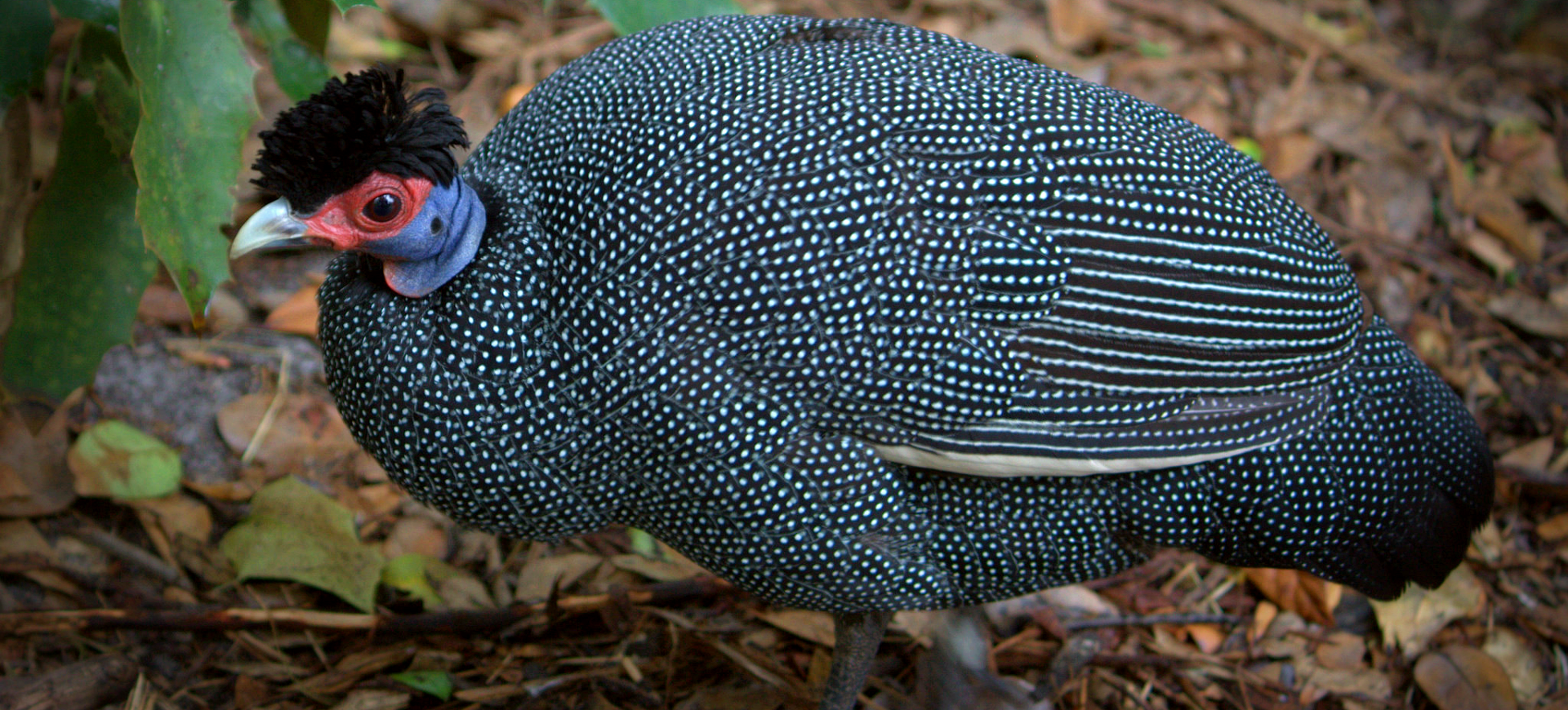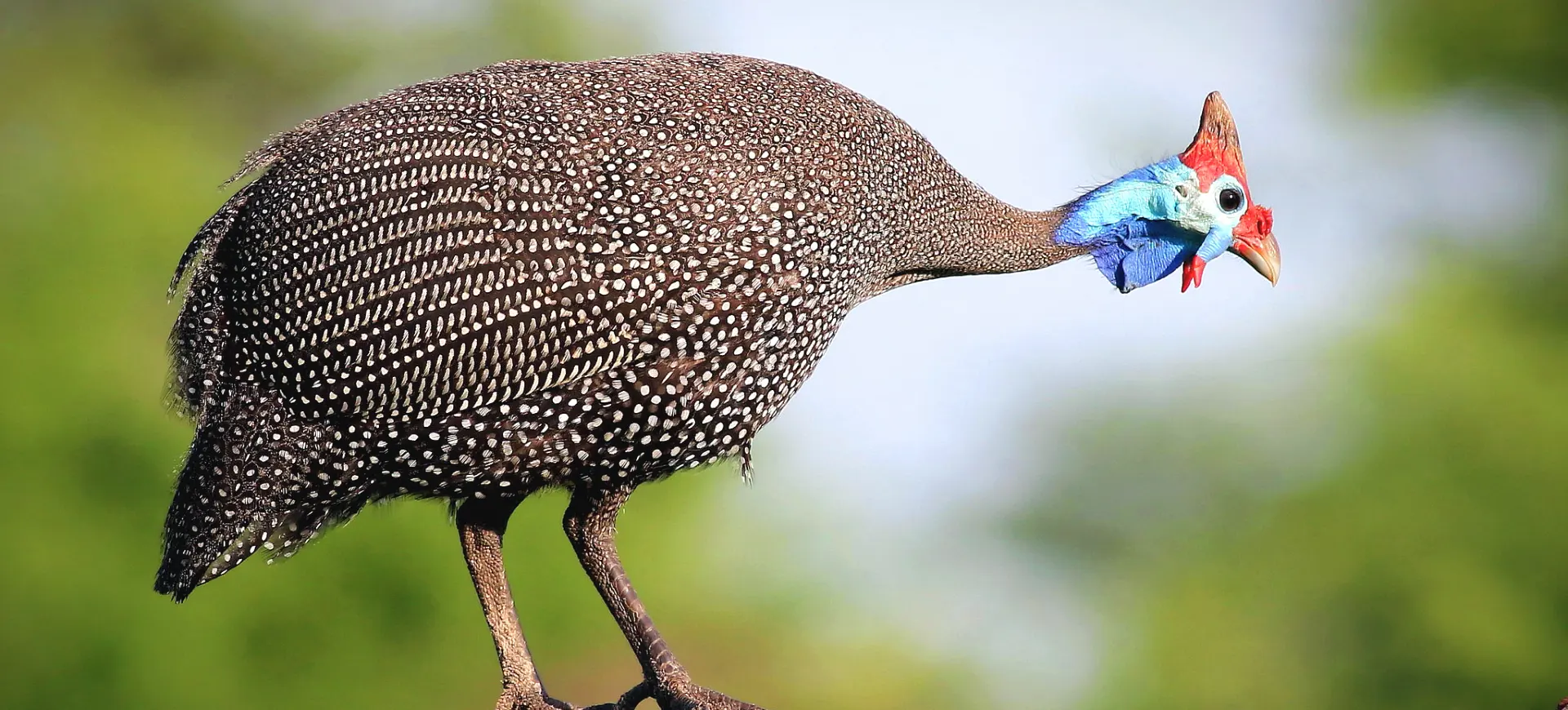Overview
The Vulturine Guineafowl is a large bird of the guineafowl family, native to the dry savannas and scrublands of Eastern Africa. Their most distinctive feature is their bare-skinned, blue and red vulturine face which gives them their name, while the rest of their body is cloaked in glossy, dark blue feathers with white spots. They are known for their peculiar behavior, including their preference to run rather than fly when threatened and the formation of large social groups.
In the social stratum of the animal kingdom, the Vulturine Guineafowl is valued for its striking appearance and ecological role as a ground-dwelling insectivore, keeping pest populations in check. They have complex social structures, akin to primate groups, exhibiting cooperative and competitive behaviors within large groups. Vulturine Guineafowl also displays unique mating behaviors, with males engaging in visually stunning displays to court females.
Vulturine Guineafowl has a significant presence in the culture of indigenous tribes of Eastern Africa, especially as a food source and an emblem of beauty in folklore. They are also gaining popularity in exotic poultry collections worldwide. Despite their resilience, habitat loss and hunting challenge their populations, necessitating conservation efforts to ensure their continued survival.
Taxonomy
Kingdom
Phylum
Class
Order
Family
Genus
Species
Type
Physical Description:
The Vulturine Guineafowl exhibits a striking blend of colors and textures, giving it an unmistakable appearance among avian species. Their head is small and vulturine, devoid of feathers and adorned with blue and red colors. A patch of cobalt blue skin adorns the chest, contrasting sharply with the crimson around their eyes and the delicate, straw-colored tuft on their heads. The lower neck and upper breast display a mantle of hackle-like feathers giving the appearance of a ruffled collar.
The body is covered in a cloak of glossy, dark blue feathers, each meticulously dotted with white spots, providing the bird with a starry allure. The thin, long legs are a muted gray, contrasting with the otherwise vibrant color palette. Despite being capable of flight, they have short, rounded wings, often used for balance during their high-speed runs. Both sexes look similar, although males are slightly larger and have an enormous tarsal spur.

Lifespan: Wild: ~15 Years || Captivity: ~20 Years

Weight: Male: 3.3 lbs (1.5 kg) || Female: 3.1 lbs (1.4 kg)

Length: Male: 24 inches (60 cm) || Female: 22 inches (55 cm)

Top Speed: 10 mph (16 km/h)
Characteristic:
Native Habitat:
Vulturine Guineafowl inhabits the dry grasslands and shrublands of Eastern Africa. These habitats are characterized by sparse tree cover interspersed with shrubs and grasses. The birds thrive in these areas, providing ample space for their ground-dwelling lifestyle and abundant food sources like insects, seeds, and berries. Their habitats also provide ample hiding places against predators and harsh weather.
These birds are most often found in regions with a mix of open ground and some forest cover, which they use for nesting and roosting. They favor areas with a mix of tall grasses, acacia trees, and shrubs. Despite their ability to fly, Vulturine Guineafowls spend most of their time on the ground, using the thick vegetation to hide from potential predators.
Climate Zones:
Biomes:
Biogeographical Realms:
Continents:
Diet:
Diet & Feeding Habits:
Vulturine Guineafowls are omnivores, feeding on a varied diet that includes small invertebrates, seeds, berries, and roots. They spend much of their day on the ground, foraging in the undergrowth. Their preferred meals are insects, mainly beetles and termites, which they skillfully unearth from the soil. This diet of invertebrates is supplemented by plant matter during seasons when insects are less abundant.
With their ground-dwelling nature and flexible diet, Vulturine Guineafowls play an essential role in their ecosystem. They assist in controlling pest populations and also contribute to seed dispersal through their feces. Their foraging behavior also helps in soil aeration, indirectly promoting plant health. Their feeding habits do not change significantly in captivity, although they may require additional dietary supplements to maintain their health.
Mating Behavior:
Mating Description:
The Vulturine Guineafowl has a fascinating mating system, exhibiting polygynous behavior where a single male mates with multiple females. The mating season corresponds with the rainy season, which ensures ample food availability for the chicks. The male court’s females with an elaborate visual display involving fluffing up its feather and parading around prospective mates.
Eggs are laid in a simple ground nest, usually hidden among tall grass or shrubs. The female is solely responsible for incubating eggs, which lasts around 24 days. The chicks are precocial, able to run and forage for food soon after hatching, although they remain under the mother’s protection until they are mature.
Reproduction Season:
Birth Type:
Pregnancy Duration:
Female Name:
Male Name:
Baby Name:
Social Structure Description:
The Vulturine Guineafowl has a complex social structure, forming groups of up to 60 individuals. These groups are stable, meaning that individuals rarely switch groups, and many groups can coexist peacefully in areas of overlapping range. The groups exhibit cooperative and competitive behaviors, working together to find food and defend against predators but competing for mates and status within the group.
These social structures are unusual among birds, leading to comparisons with primate societies. The dominant males and females in the group often display aggressive behavior to maintain their status, while lower-ranking individuals may cooperate to improve their standing within the group. This dynamic social structure makes the Vulturine Guineafowl one of the most exciting species of guineafowl.
Groups:
Conservation Status:
Population Trend:
The exact numbers for the Vulturine Guineafowl population in the wild are uncertain, but the species is considered widespread within its range. Their populations are concentrated in protected areas like national parks and reserves where habitat disturbance is minimal. However, populations outside these areas may be at risk due to habitat destruction and hunting.
The Vulturine Guineafowl has gained popularity in captivity due to its striking appearance and intriguing behavior. They are kept in zoos, bird parks, and private aviaries worldwide. These captive populations serve as genetic reservoirs, which can be helpful for future reintroduction programs if wild populations come under significant threat.
Population Threats:
The primary threats facing the Vulturine Guineafowl include habitat loss and hunting. Due to expanding human settlements, agriculture, and deforestation, their natural habitats are increasingly encroaching upon. This not only results in loss of habitat but also leads to fragmentation, which can disrupt their social structure and breeding behavior.
Hunting for meat and feathers also significantly threatens their populations, especially outside protected areas. Despite these threats, the species has proven adaptable, surviving in varied habitats and under different conditions. However, continuous monitoring is required to ensure their populations remain stable.
Conservation Efforts:
Conservation efforts for the Vulturine Guineafowl mainly focus on habitat preservation and reducing hunting pressure. Protected areas within their range, like national parks and reserves, provide a sanctuary for these birds where their habitat is preserved and hunting is regulated.
Educational programs aimed at local communities help raise awareness about the ecological role of these birds and the importance of their conservation. In captivity, zoos and aviaries play a significant role in educating the public while providing a haven for the species. While currently not endangered, maintaining these conservation efforts is crucial for the future survival of the Vulturine Guineafowl.
Additional Resources:
Fun Facts
- The Vulturine Guineafowl gets its name from its vulture-like appearance, characterized by its bare, bluish head and neck.
- Despite being able to fly, these birds prefer to run when threatened.
- Vulturine Guineafowls are one of the largest extant species of guineafowl.
- They are known for their complex social structures, which resemble those of primates.
- The Vulturine Guineafowl is a polygynous species, with males often having multiple female mates.
- Chicks of the Vulturine Guineafowl are precocial and can run and forage soon after hatching.
- Their diet of insects makes them natural pest controllers.
- They play a significant role in seed dispersal in their habitats.
- Vulturine Guineafowls are becoming popular in the exotic pet trade due to their striking appearance and exciting behavior.
- Despite their name, these birds are not scavengers like vultures but are omnivorous, feeding on small invertebrates and plant matter.








